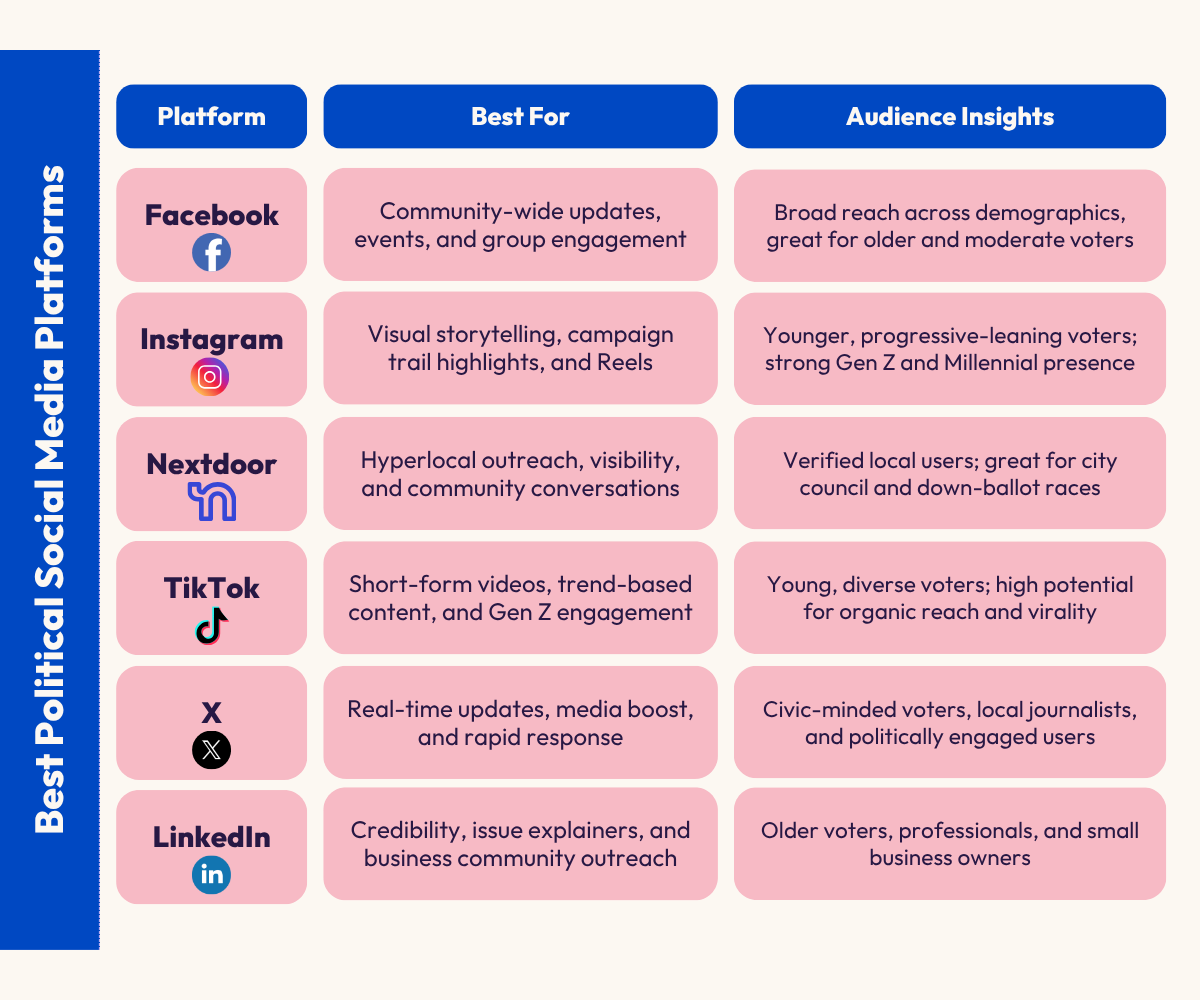
The 6 Best Political Social Media Platforms for 2025
Social media is one of the most powerful and accessible tools Independent candidates can use to grow their campaigns, connect with voters, and inspire action. With the right platform mix and content strategy, you can build grassroots momentum, increase name recognition, and speak directly to your community, no party required.
In this guide, we’ll explore the best political social media platforms for Independent candidates and explain how to use each one strategically to connect with voters and win local support.
Why Social Media Platforms Matter in Independent Campaigns
As of 2025, more than 250 million Americans use social media. For Independent candidates running without party infrastructure, that means one thing: you need to do more with less and do it where your voters already are.
In today’s digital-first political landscape, strategic use of political social media platforms can help level the playing field by allowing you to:
Build awareness and visibility in your community
Share your story and priorities in your own words
Respond to local issues in real time
Humanize your campaign through authentic storytelling
Mobilize supporters to donate, volunteer, and vote
It’s not just about being online, though. It’s about being smart with where and how you show up.
While 54% of Americans report often or sometimes getting their news about local politics from social media, over 70% of adults aged 18 to 29 often or sometimes get their political news from various social platforms. If you’re trying to reach young voters, platforms like Instagram, TikTok, and X should be key parts of your strategy.
Knowing who your voters are and which platforms they use can help you tailor your content and turn digital outreach into real-world support.
The 6 Best Political Social Media Platforms for Candidates
Each social media platform serves a different purpose in your campaign strategy. Some are better for emotional storytelling, others for real-time updates or targeting specific audiences.
Here are our top five social platforms for political campaigns, especially for Independent and third-party candidates:
#1: Facebook: Best for Broad Reach and Community Groups
Still the biggest platform by user count, with 68% of Americans using it as of 2025, Facebook is where many voters across age groups and political backgrounds spend their time. It’s especially strong for engaging with older voters and local community groups.
Use Facebook to:
Share campaign updates, videos, and event invites
Create a campaign page with contact info, bios, and donation links
Run targeted ads to reach voters by location, age, or interest
Join and post in local Facebook groups to expand your reach
Go live to answer questions and build momentum
Post regularly and reply to comments to keep engagement high. Voters will notice if you go quiet for weeks.
LEARN MORE: Reach the most voters with our top tips for increasing your campaign’s visibility.
#2: Instagram: Best for Visual Storytelling and Behind-the-Scenes Content
Instagram is where you bring your campaign to life. Through photos, Stories, and Reels, you can show voters what you’re up to and why it matters.
Use Instagram to:
Share photos from canvassing, events, or personal moments
Post Reels explaining your campaign priorities or answering FAQs
Use Stories to show your day-to-day on the campaign trail
Run ads to target specific voter demographics
Highlight local supporters, volunteers, or endorsements
Instagram skews younger and more progressive. If you’re trying to connect with first-time voters or Gen Z, this is where you should be showing up consistently.
Instagram has become a proven tool in modern political campaigns. Candidates like Zohran Mamdani have built name recognition and driven turnout using platforms like Instagram and TikTok. Mamdani’s viral videos showed him on the streets of New York City, explaining his plans for free buses and municipal grocery stores, and those videos resonated with local voters, helping him secure a resounding primary election win.
It’s also a powerful tool for fostering relationships with constituents after election day. In Oakland, California, for example, some city council members are using Instagram to connect with their audiences in more personal ways, creating content ranging from professional to personal and informing their constituents of things happening in the city.
LEARN MORE: Need post ideas? Browse sample social media posts and volunteer post templates in the GoodParty.org Community.
#3: Nextdoor: Best for Hyperlocal Visibility and Neighborhood Outreach
Nextdoor isn’t flashy, but it’s powerful for local races. It focuses on neighborhood-level engagement, making it ideal for candidates running for school board, city council, or village offices.
Use Nextdoor to:
Share announcements with verified local users
Post about campaign events or town halls
Join discussions about local issues
Build trust with neighbors through consistent, civil engagement
When using Nextdoor, remember these are your real neighbors. Try to avoid coming off too promotional. Instead, participate in conversations like a neighbor who cares (because you are).
#4: TikTok: Best for Reaching Younger Voters and Going Viral
If you’re comfortable on camera, TikTok can be a game-changer. You don’t need a big production budget, just a phone, good lighting, and a message.
Use TikTok to:
Answer common voter questions with short, authentic videos
Respond to trends with campaign-specific twists
Share powerful personal stories or local concerns
Highlight endorsements and campaign milestones
TikTok users skew young and diverse. It’s one of the few platforms where an Independent candidate can reach thousands (or millions) without spending a dime.
TikTok isn’t new to political content, either. Political influencer Parker Short uses his platform on TikTok to generate attention and conversation about local issues in Georgia, ranging from local elections to highway and transportation policy. Local candidates have also found virality through TikTok, like Zohran Mamdani in NYC, boosting their name recognition and getting younger voters to the polls even outside presidential election years.
LEARN MORE: See how to go viral during your political campaign.
#5: X (Formerly Twitter): Best for Real-Time Updates and Local Engagement
X may have changed its name and tone over the years, but it remains one of the most effective platforms for real-time political communication. For Independent candidates without mainstream media coverage, it’s an essential space to share updates, tag local reporters, and join conversations as they happen.
Use X to:
Post breaking campaign news, event updates, and election reminders
Engage with local reporters and media outlets
Join trending conversations using relevant hashtags
Respond quickly to misinformation or emerging issues
Boost visibility by running ads on X and tagging journalists, civic orgs, and peer candidates in posts
While X's audience has narrowed in recent years, it still punches above its weight in terms of influence, specifically around politics. According to Pew Research, 59% of Americans say they specifically use X to keep up with politics and political issues, and 74% of users report seeing political content while using X normally. From local reporters to politically engaged voters, X is a prime place to amplify your message without spending money.
Remember to keep your posts concise, timely, and bold. Retweet your supporters, tag your volunteers, and show you're plugged in.
#6: LinkedIn: Best for Professional Voters and Policy Credibility
LinkedIn may not be your primary platform, but it’s ideal for establishing your qualifications and connecting with business-minded voters.
Use LinkedIn to:
Publish posts about your background, vision, and policy ideas
Highlight endorsements or past experience
Share earned media coverage or campaign wins
Network with local civic and business leaders
Think of LinkedIn as your campaign résumé. Keep it professional, values-driven, and policy-forward.
Choosing the Right Political Social Media Platforms for Your Campaign
You don’t need to be everywhere, but you should be where your voters are.
Here’s a quick cheat sheet:

Consistency matters more than frequency. Pick two to three platforms you can manage well and post regularly.
Best Practices for Social Media Campaign Content
No matter which platforms you focus on, apply these core strategies:
Be authentic: Voters want to hear from the real you, not a scripted politician.
Use visuals: Images and videos perform better across all platforms.
Engage consistently: Respond to comments and messages when you can.
Share calls to action: Include links to donate, volunteer, or vote.
Highlight your community: Show up for the people you want to represent.
Mastering these best practices doesn’t require a huge budget or a social media team. You just need consistency, clarity, and a commitment to showing up authentically. Don’t treat social media as a side task. It should be an integral part of your field strategy.
LEARN MORE: Need help planning your social strategy? Read our full guide on how to use social media for political campaigns.
Save Time With Free Social Media Tools for Candidates
Creating content across platforms can be time-consuming, but you don’t have to do it alone.
GoodParty.org’s Content Builder gives Independent and non-partisan candidates a head start with:
AI-powered templates for social media posts, emails, and scripts
Ready-to-edit copy for campaign announcements, events, and GOTV
Free tools to build your website and message faster
Whether you’re just getting started or trying to keep momentum up mid-campaign, the Content Builder is built to save you time, so you can spend more of it talking to voters.
LEARN MORE: Explore how GoodParty.org's free and low-cost tools can streamline your content, grow your reach, and stay on message.
Social Media: Your Grassroots Megaphone
Social media platforms aren’t just places to post selfies or talk politics. They’re spaces where real conversations, community organizing, and civic action happen every day.
Political social media platforms give Independent candidates a direct line to voters. They let you share your story in your own words, respond to real-time issues, and build the kind of grassroots energy that money can’t buy. From Instagram Reels and TikTok videos to Facebook event invites and neighborhood conversations on Nextdoor, social media is where campaigns grow and movements begin.
The key isn’t being everywhere. It’s showing up consistently where your voters are, with content that’s clear, local, and true to who you are.
Whether you're just starting your city council run or deep into a school board campaign, don’t overlook the power of showing up online. With the right tools and strategy, your next post could be the one that moves a supporter to volunteer, donate, or vote.
Photo by Creative Christians on Unsplash
Ready to start posting? Build your strategy with GoodParty.org, and take the first step toward running and winning your campaign your way.

